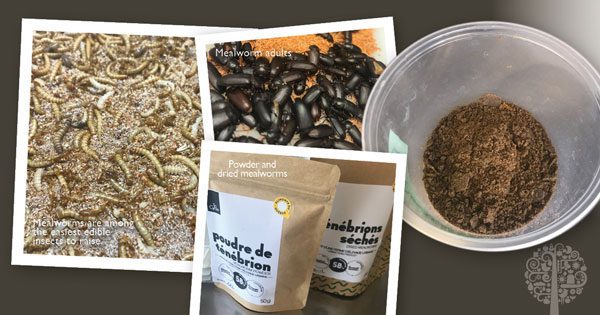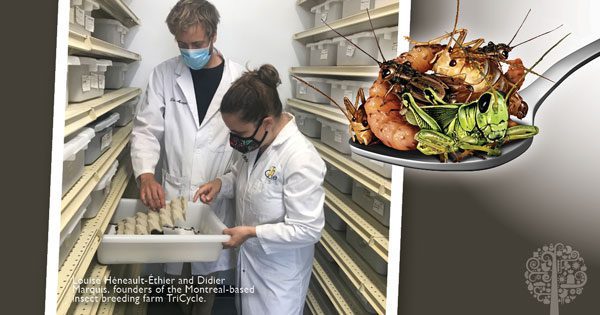When it comes to the food we eat, more and more people have environmental concerns, including a desire for fairer treatment of animals.
For example, it is estimated that about one-third of North Americans avoid eating meat at least one day a week. Also, a survey carried out a few years ago reports that 56% of French people say they eat less meat than in previous years. Only 3% have increased their consumption.

Mealworms are among the easiest edible insects to raise. credit: Albert Mondor
Consumed by around two billion people, insects are seen by many as an environmentally-friendly alternative to red meat consumption. Prevalent in the traditional cultures of many populations in Latin America, Africa, and Asia, entomophagy – a term referring to eating insects – is starting to generate interest in Europe and North America.
It is in this spirit that insect farming is emerging in many places across these continents. The primary insects being raised by these start-up companies are black soldier flies, Buffalo worms, crickets, locusts, and mealworms.
Young entrepreneurs who engage in insect breeding are filled with enthusiasm and ideas to increase the production and consumption of these new sources of protein.
In France, for example, a company raised a record 110 million euros to finance the world’s largest insect production plant in Poulainville, Hauts-de-France.
Entomofarm is a large Canadian company that raises crickets with the support of some big players in the food industry, including Maple Leaf and Loblaws, which markets the products.
The province of Quebec is home to nearly 40 companies that raise edible insects. An association of insect breeders and processors has also recently emerged there.
Ecological Breeding
Insect production is particularly eco-friendly when compared to typical cattle farming. Producing one kilogram of beef requires 30 to 40 kilograms of grain and fodder. On the other hand, raising one kilogram of insects involves the input of only 1 to 5 kilograms of plants.
At TriCycle in Montreal, QC, 94% of plant substances used to feed the insects come within a 5 km radius of the farm. Brewery dregs, bakery residues, and fruit pulp from juices make up the bulk of the food for the insects raised on this farm.

Louise Héneault-Éthier and Didier Marquis, founders of the Montreal-based insect breeding farm TriCycle. credit: Albert Mondor
Main advantages of rearing edible insects:
- The breeding of insects can be done with organic waste.
- Raising insects uses less water and produces fewer greenhouse gases than livestock.
- Insects reproduce quickly and can be raised in small areas.
- Insects are a healthy and nutritious food resource, rich in fats, proteins, vitamins, fibres, and minerals.
Food Galore
A typical small farm covering about 50 square meters produces 50 million insects every year! The insects are generally raised in plastic containers arranged on shelves. Insects are fed and moved regularly according to their stage of development.
The two most popular products offered by these companies are whole insects and insect powder. The powder can be incorporated into protein bars, burgers, bread, and pasta. And recent years have seen the development of many insect-based recipes for things like tapenade, shepherd’s pie, and dumplings!
Fertiliser
In addition to producing an impressive amount of insects, a farm also generates frass, a substance composed of manure and insect moults. Insects go through various stages of growth that involve a change in their outer skeleton. These exoskeletons (or moults) are mixed with manure.
Frass is a low-odour fertilizer that looks like light brown flour. It contains about 3% nitrogen, 4% phosphorus, and 2% potassium. This fertilizer also contains a significant amount of chitin, a substance that stimulates microbial life in the soil and improves the rooting, growth, and development of plants. Some scientific studies also show that chitin improves the resistance of plants to diseases and drought.